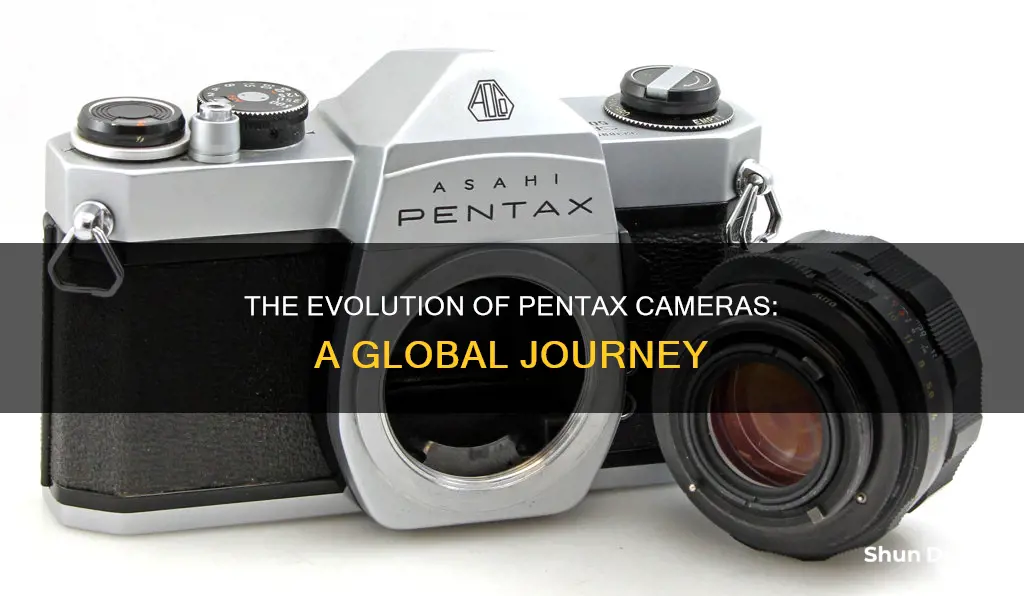
Pentax is a Japanese camera and lens manufacturer with a rich history. The company was founded in 1919 as Asahi Optical Company and changed its name to Pentax Corporation in 2002. It is currently owned by Ricoh Imaging Corp, which bought the brand from Hoya in 2011. Pentax cameras have a strong following, particularly among those who appreciate their retro design and optical viewfinders. The company has a long history of innovation in the camera industry, including the release of the first Japanese 35mm SLR camera in 1952. Today, Pentax continues to develop new film and digital cameras, with a focus on providing exciting and innovative products for its dedicated customer base.
| Characteristics | Values |
|---|---|
| Founded | 1919 |
| Original Name | Asahi Optical Company |
| Current Owner | Ricoh Imaging Corp. |
| Founder | Kajiwara Kumao |
| Collaborator | Matsumoto Saburo |
| First Camera Produced | Asahiflex |
| First Camera Release Date | 1952 |
| Current Name Adopted | 2002 |
What You'll Learn

Pentax's history and ownership
Pentax, now owned by Ricoh Imaging, is a renowned name in the world of photography. The brand has long been associated with quality, innovation, and resilience, with a rich history spanning several decades.
The origins of Pentax can be traced back to 1919, when the Asahi Optical Joint Stock Co. was established in Tokyo, Japan. Initially, the company specialised in manufacturing optical lenses and glasses, marking its entry into the world of optics and imaging.
In the 1950s, Asahi Optical expanded its focus to the burgeoning field of photography, introducing the Asahiflex, Japan's first single-lens reflex (SLR) camera. This groundbreaking innovation not only propelled Asahi Optical to the forefront of the Japanese camera industry but also set the tone for the company's future as Pentax.
The following decades witnessed a period of rapid expansion and technological advancements for Pentax. They made a significant impact on the market with the launch of the Pentax Spotmatic, a groundbreaking SLR camera that showcased the brand's technical prowess. The company continued to push boundaries, introducing the K series, which included the iconic K1000, celebrated for its simplicity, reliability, and durability.
Pentax also ventured into medium format territory with the Pentax 6x7, offering professional-level image quality in a more compact and user-friendly package. This diversification further solidified Pentax's reputation as a brand that embraced both innovation and diversity.
As the digital age dawned, Pentax once again demonstrated its adaptability by introducing the Pentax Optio series of digital compact cameras. They also made a significant leap into the digital SLR market with the launch of the Pentax *ist D, showcasing their commitment to evolving with technological advancements.
However, alongside these technological advancements, Pentax also underwent significant corporate changes. In 2007, the brand was acquired by Hoya Corporation, and subsequently, in 2011, it was purchased by Ricoh, leading to the establishment of Pentax Ricoh Imaging. Despite these shifts in ownership, the Pentax name and its legacy of high-quality, innovative cameras have endured.
In recent years, Pentax (Ricoh Imaging) has continued to make strides, particularly with the introduction of the Pentax K series of DSLRs, catering to photographers across a range of needs and budgets. Additionally, the launch of the Pentax 645Z, a medium format digital camera, has brought exceptional image quality to a broader audience.
Throughout its history, Pentax has been a pioneer in camera technology, adapting to shifting consumer demands and industry trends. The brand has weathered corporate changes, ownership transitions, and market challenges while retaining its dedication to delivering cutting-edge photographic equipment.
The Evolution of Fake Cameras: Where Are They Made?
You may want to see also

The evolution of Pentax cameras
The history of Pentax cameras began in 1919 when the company was founded as Asahi Optical Joint Stock Co. in Otsuka, Tokyo. The company's first products were lenses for eyeglasses, but it soon expanded into manufacturing lenses for projectors, binoculars, and cameras. In 1952, Asahi Optical released the "Asahiflex l", the first domestically manufactured single-lens reflex (SLR) camera in Japan. This marked the beginning of the Pentax brand as a pioneer of SLR cameras.
Over the years, Pentax continued to innovate and introduce new products, such as the world's first through-the-lens (TTL) metering system in 1964 and the world's first autofocus SLR camera in 1980. In 1981, Pentax Corporation became the first camera manufacturer to reach the production milestone of 10 million SLR cameras.
In the early 2000s, Pentax underwent several corporate changes, merging with Hoya Corporation in 2007 and then being acquired by Ricoh Imaging in 2011. The company name was changed to Ricoh Imaging Company Ltd. in 2013, but the Pentax brand was retained for DSLRs, interchangeable-lens compact cameras, and binoculars.
Pentax has continued to develop and release new camera models, such as the K-1 full-frame DSLR in 2016 and the K-3 III in 2021. The company has also expanded into mirrorless interchangeable-lens cameras, such as the Pentax Q range introduced in 2011.
Throughout its history, Pentax has been known for its dedication to manufacturing excellence and expanding the possibilities of creators. The company's cameras and lenses have been widely used and well-regarded by photographers and enthusiasts around the world.
Olympus Cameras: Made in Japan?
You may want to see also

Pentax camera features
Pentax cameras have a rich history, with the company being founded in 1919 as Asahi Optical Company. Over the years, Pentax has released a range of cameras with various features, establishing itself as one of the oldest camera brands in the world. Here are some of the key features found in Pentax cameras:
- Optics and Image Quality: Pentax is known for its excellent optics and high-quality imaging devices. Their DSLR cameras, including the K and KP range, offer both APS-C and full-frame sensor sizes, capturing incredible detail even in low light.
- In-Body Stabilisation: The K-1 series, aimed at professionals and enthusiasts, includes in-body stabilisation for sharper images, especially in low-light conditions or when using longer shutter speeds.
- Pixel Shift Resolution: The K-1 series also features pixel shift technology, allowing for ultra-high-resolution images by capturing multiple images with a slight shift in the sensor position and then combining them.
- High ISO Competency: Both the K-1 and KP series boast impressive high ISO capabilities, enabling photographers to capture clear and detailed images in low-light conditions without excessive noise.
- Weather Sealing: Pentax cameras, including the K-1 and KP series, often feature extreme weather sealing, making them suitable for use in various environments and conditions.
- Optical Viewfinders: Pentax places emphasis on traditional optical viewfinders, as seen in the KP range, which offers high-performance optical viewfinders for clear and bright image composition.
- Portability: The KP series is designed with portability in mind, featuring thin and lightweight models that photographers can easily carry on their travels without compromising on performance.
- Exposure Modes: Pentax cameras offer a variety of exposure modes, such as Program mode (P), Aperture Priority (Av), Shutter Priority (Tv), Sensitivity Priority (Sv), and Manual mode (M). These modes provide flexibility and control over aperture, shutter speed, and ISO settings, catering to different shooting scenarios.
- Auto and Scene Modes: For beginners or quick snapshots, Pentax cameras provide Auto and Scene modes. Auto mode sets the camera's best-guessed exposure parameters, while Scene mode offers specific settings for various scenarios like macro, portrait, landscape, and night scenes.
- Customisable Settings: Pentax cameras allow users to customise and save their preferred settings with modes like U1 and U2. This is ideal for photographers who frequently shoot in specific styles or lighting conditions, eliminating the need to adjust settings for each shot.
- Bulb Mode: For long exposure photography, Pentax cameras offer Bulb mode, where the shutter stays open as long as the shutter button is depressed, allowing for creative shots of waterfalls, seascape, or night scenes.
- Video Recording: Some Pentax cameras, like the K-50, support HD video recording. Users can simply press the shutter button to start and stop video recording.
- Lens Compatibility: Pentax cameras are compatible with a wide range of high-quality K-mount lenses, providing photographers with numerous options to suit their specific needs and ensuring they can capture outstanding images.
Mastering Photography: Understanding P Mode on Your SLR
You may want to see also

Pentax's move to online sales
In 2022, Pentax and Ricoh announced that they would be stopping mass production of their cameras in Japan and moving to online sales. This move was intended to create a more direct-to-consumer approach and improve efficiency by producing only the number of cameras needed. The change also aimed to enhance the customer experience by offering a 'workshop-like' manufacturing process and providing more opportunities for customers to connect directly with the company.
This shift to online sales was not expected to affect the North American market, with Ricoh Imaging Americas Corporation stating that customers in North America could continue to purchase Ricoh and Pentax cameras through authorized dealers and their website. However, the change represented a significant shift in the company's distribution strategy, moving away from the traditional mass production and sales model.
The decision to transition to online sales and a more direct-to-consumer approach was influenced by several factors. Firstly, Ricoh recognized that the market environment was changing, and the conventional method of mass production and sales was becoming less effective. By adopting a more direct approach, they could better respond to customer desires and produce cameras that met the specific needs of their users.
Additionally, the move to online sales was expected to provide several benefits. It would allow Ricoh to have better control over their finances and inventory, as they would only produce the number of cameras required. It would also enable them to offer improved customer service and quality control. Furthermore, the online platform would facilitate a more personal level of connection with customers, potentially even allowing for custom camera orders.
The transition to online sales and direct-to-consumer engagement represented a significant shift in Pentax and Ricoh's business model. By embracing this change, the companies aimed to enhance the customer experience, streamline their operations, and adapt to the evolving market environment.
Unlocking Your Camera: Powering On Without the Cover
You may want to see also

Pentax's future
Pentax is a Japanese camera manufacturer with a rich history. The company was founded in 1919 as Asahi Optical Company and changed its name to Pentax Corporation in 2002. It is currently owned by Ricoh Imaging Corp, which acquired the company from Hoya Corporation in 2011.
In recent years, Pentax has faced some challenges and has seen its market share decline. The company has released only a few new models, with a focus on DSLRs and premium models rather than mirrorless options. While this strategy may appeal to dedicated hobbyists who appreciate optical viewfinders, it has left Pentax lagging behind its competitors in terms of innovation.
However, there are signs that Pentax is working to improve its product offerings. In 2018, the company announced the development of a new flagship APS-C DSLR, the K-3 III, which was released in 2021. Pentax has also expressed interest in maximizing the still image quality of its cameras and has introduced new lenses for its full-frame models.
One area where Pentax has struggled to keep up is video capabilities. The company has acknowledged the need for improvements and plans to add 4K video support to its DSLRs, but this will require new hardware. Additionally, Pentax has not released a new "GR" compact camera since 2013, but there are rumours of a new model in the works.
In conclusion, while Pentax has faced some challenges in recent years, the company is working to improve its product offerings and maximise the still image quality of its cameras. By focusing on its strengths and catering to a dedicated customer base, Pentax may be able to secure a bright future for itself in the camera industry.
Charging Your 4K Ultra HD Camera: A Step-by-Step Guide
You may want to see also
Frequently asked questions
Pentax cameras are made in Japan.
Pentax is currently owned by Ricoh Imaging Corp.
Pentax was founded in 1919 as Asahi Optical Company and changed its name to Pentax Corporation in 2002. The company has a rich history in the camera industry, particularly with its DSLRs and affordable full-frame cameras.
Notable Pentax camera models include the K-1, K-3 III, K-5 II, K-50, K-500, K-7, K-r, K20D, K100D, and the MZ series.







